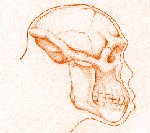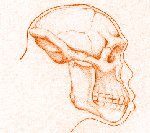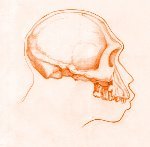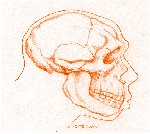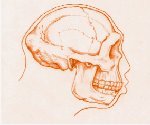Back to contents
Back
| Locality | Paleoenvironment | Fossil Description |
|---|---|---|
| Hadar
|
Lake and associated flood plain with braided streams and rivers
(Aronson and Taieb 1981; Gray 1980)
Although a general drying of the African continent continued throughout the Pliocene (5.3 - 1.8 Ma) the Hadar region and North East Africa remained relatively moist (Chandler, M) |
Most famous for the discovery of "Lucy" and the "First Family"
both Australopithecus afarensis (D.Johanson 1974/75). Lucy - 40 % complete skeleton including pelvis, femur, and tibia indicating bipedalism. 3.2 Ma First Family - 13 individuals of all ages, and varying sizes (may be a mix of species). 3.2 Ma |
Olduvai Gorge
|
Salt lake with surroundig flood plains with seasonal streams and rivers and dry grasslands savannah; tectonic changes after 1.5 Ma ago resulted in the drying up of the lake (Hay 1976, 1981; Isaac 1984). |
Various Homo habilis remains, mostly teeth and skull fragments (Leakey et al. 1964 and
P. Nzube 1968); 1.8 - 1.6 Ma Homo erectus remains:
|
| Koobi Fora
|
Before ~ 1.6 Ma fresh lake with flood-plains, gallery forests and dry thorn savannahs; During later times the lake fluctuated from fresh to brackish water. | Homo habilis or rudolfensis, most complete habilis skull
to date, discovered by B. Ngeneo 1972 (Leakely 1973); brain size 750 cc: 1.9 Ma.
Homo erectus discovered by B. Ngeneo 1975; almost complete cranium, large brain size
about 850 cc. Found with A. boisei confirming presence of more that one hominid species
existing at one time (Leakey and Walker 1976); 1.7 Ma. |
Omo/Turkana
|
Before ~ 2.1 Ma, a large lake and gallery forests around rivers, many aquatic animals are found, with few terrestrial animals. Overall drying through time, reducing the forests to river/lake margins. (Bonnefille 1976, 1979; Brown 1981). | Australpithecus aethiopicus discovered by Alan Walker in 1985, in West
Turkana, Kenya. An almost complete cranium (The "Black Skull") with primitive and advanced
features, ~ 410 cc. brain size, 2.4 Ma.
Australopithecus boisei
|
| South Africa "Transvaal" includes: Makapansgat, Sterkfontein, Swartkrans, Kromdraai, and Taung
|
All locals were mosaic savannah environments with Makapansgat Member 3 and Sterkfontein Member 4 being less open (more bush/woodland) that Swartkrans Mb1 and Sterkfontwin Mb5 - this suggests a trend from wetter to drier conditions through time (Vrba 1975, 1976, 1985). |
Australopithecus africanus "Taung" Child, discovered by Raymond Dart in 1924, full face teeth and jaws, and endocranial
cast of the brain. Thought to be a child of 3-5 years, 410 cc brain size, bipedal, 2 - 3 Ma. Australopithecus africanus, Broom and Robinson 1947; Sterkfontien, nearly complete vertabral column, pelvis, some rib fragments. Pelvis more human than apelike, indicating bipedalism (Brace et al. 1979) 2.5 Ma Homo habilis Sterkfontein; Discovered by Alan Hughes in 1976 (Hughes and Tobias 1977). Cranial fragmants and teeth, found together with stone tools. 1.5 - 2 Ma. |
|
Africa and Beyond
| Various Paleoenvironments all with water present, lakes, coasts, rivers etc. |
Homo habilis "Java Man", discovered by Eugene Dubois 1891, Indonesia.
Consists of flat thick skullcap, and a few teeth. brain size 940 cc, 700,000 BP. Homo erectus "Peking Man", through 1929 to 1937; 14 partial craniums, 11 lower jaws, many teeth , bones and stone tools were found in in Peking Man site near Beijing China (Davidson Black prior to 1934; , Franz Weidenreich until 1941). Fossils lost during WW2, casts still available. Age is about 500,000 - 300,000 BP. Brain sizes range from 915 - 1225 cc. Homo erectus Java, Sartono 1969, almost complete cranium; oldest erectus find on Java, 1.7 Ma (recent dating), 800K (old dating) brain size 1000 cc. Homo sapiens (archaic)
|
Back to contents
Back
